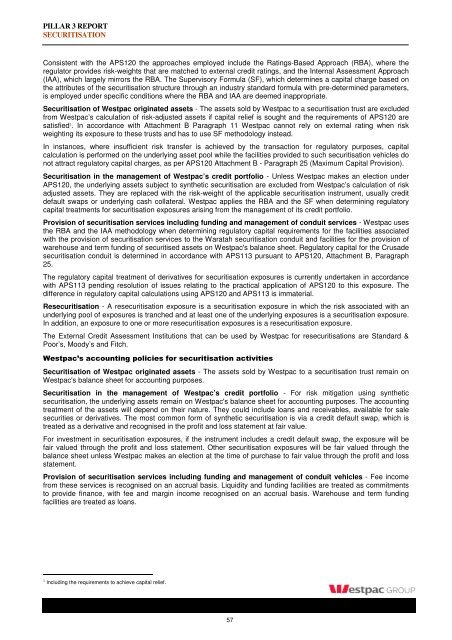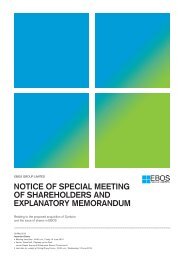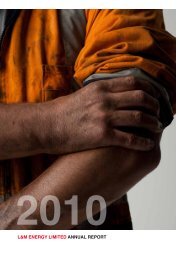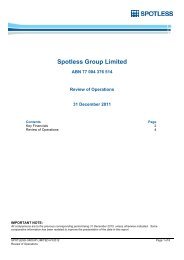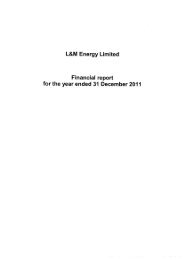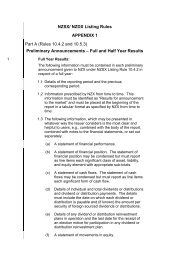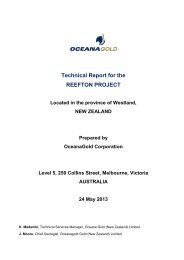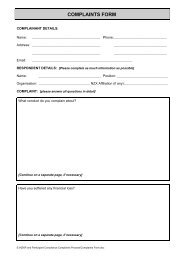Westpac Group Pillar 3 Report March 2013 - Iguana IR Sites
Westpac Group Pillar 3 Report March 2013 - Iguana IR Sites
Westpac Group Pillar 3 Report March 2013 - Iguana IR Sites
Create successful ePaper yourself
Turn your PDF publications into a flip-book with our unique Google optimized e-Paper software.
PILLAR 3 REPORT<br />
SECURITISATION<br />
Consistent with the APS120 the approaches employed include the Ratings-Based Approach (RBA), where the<br />
regulator provides risk-weights that are matched to external credit ratings, and the Internal Assessment Approach<br />
(IAA), which largely mirrors the RBA. The Supervisory Formula (SF), which determines a capital charge based on<br />
the attributes of the securitisation structure through an industry standard formula with pre-determined parameters,<br />
is employed under specific conditions where the RBA and IAA are deemed inappropriate.<br />
Securitisation of <strong>Westpac</strong> originated assets - The assets sold by <strong>Westpac</strong> to a securitisation trust are excluded<br />
from <strong>Westpac</strong>’s calculation of risk-adjusted assets if capital relief is sought and the requirements of APS120 are<br />
satisfied 1 . In accordance with Attachment B Paragraph 11 <strong>Westpac</strong> cannot rely on external rating when risk<br />
weighting its exposure to these trusts and has to use SF methodology instead.<br />
In instances, where insufficient risk transfer is achieved by the transaction for regulatory purposes, capital<br />
calculation is performed on the underlying asset pool while the facilities provided to such securitisation vehicles do<br />
not attract regulatory capital charges, as per APS120 Attachment B - Paragraph 25 (Maximum Capital Provision).<br />
Securitisation in the management of <strong>Westpac</strong>’s credit portfolio - Unless <strong>Westpac</strong> makes an election under<br />
APS120, the underlying assets subject to synthetic securitisation are excluded from <strong>Westpac</strong>’s calculation of risk<br />
adjusted assets. They are replaced with the risk-weight of the applicable securitisation instrument, usually credit<br />
default swaps or underlying cash collateral. <strong>Westpac</strong> applies the RBA and the SF when determining regulatory<br />
capital treatments for securitisation exposures arising from the management of its credit portfolio.<br />
Provision of securitisation services including funding and management of conduit services - <strong>Westpac</strong> uses<br />
the RBA and the IAA methodology when determining regulatory capital requirements for the facilities associated<br />
with the provision of securitisation services to the Waratah securitisation conduit and facilities for the provision of<br />
warehouse and term funding of securitised assets on <strong>Westpac</strong>'s balance sheet. Regulatory capital for the Crusade<br />
securitisation conduit is determined in accordance with APS113 pursuant to APS120, Attachment B, Paragraph<br />
25.<br />
The regulatory capital treatment of derivatives for securitisation exposures is currently undertaken in accordance<br />
with APS113 pending resolution of issues relating to the practical application of APS120 to this exposure. The<br />
difference in regulatory capital calculations using APS120 and APS113 is immaterial.<br />
Resecuritisation - A resecuritisation exposure is a securitisation exposure in which the risk associated with an<br />
underlying pool of exposures is tranched and at least one of the underlying exposures is a securitisation exposure.<br />
In addition, an exposure to one or more resecuritisation exposures is a resecuritisation exposure.<br />
The External Credit Assessment Institutions that can be used by <strong>Westpac</strong> for resecuritisations are Standard &<br />
Poor’s, Moody’s and Fitch.<br />
<strong>Westpac</strong>’s accounting policies for securitisation activities<br />
Securitisation of <strong>Westpac</strong> originated assets - The assets sold by <strong>Westpac</strong> to a securitisation trust remain on<br />
<strong>Westpac</strong>'s balance sheet for accounting purposes.<br />
Securitisation in the management of <strong>Westpac</strong>’s credit portfolio - For risk mitigation using synthetic<br />
securitisation, the underlying assets remain on <strong>Westpac</strong>'s balance sheet for accounting purposes. The accounting<br />
treatment of the assets will depend on their nature. They could include loans and receivables, available for sale<br />
securities or derivatives. The most common form of synthetic securitisation is via a credit default swap, which is<br />
treated as a derivative and recognised in the profit and loss statement at fair value.<br />
For investment in securitisation exposures, if the instrument includes a credit default swap, the exposure will be<br />
fair valued through the profit and loss statement. Other securitisation exposures will be fair valued through the<br />
balance sheet unless <strong>Westpac</strong> makes an election at the time of purchase to fair value through the profit and loss<br />
statement.<br />
Provision of securitisation services including funding and management of conduit vehicles - Fee income<br />
from these services is recognised on an accrual basis. Liquidity and funding facilities are treated as commitments<br />
to provide finance, with fee and margin income recognised on an accrual basis. Warehouse and term funding<br />
facilities are treated as loans.<br />
1 Including the requirements to achieve capital relief.<br />
57


